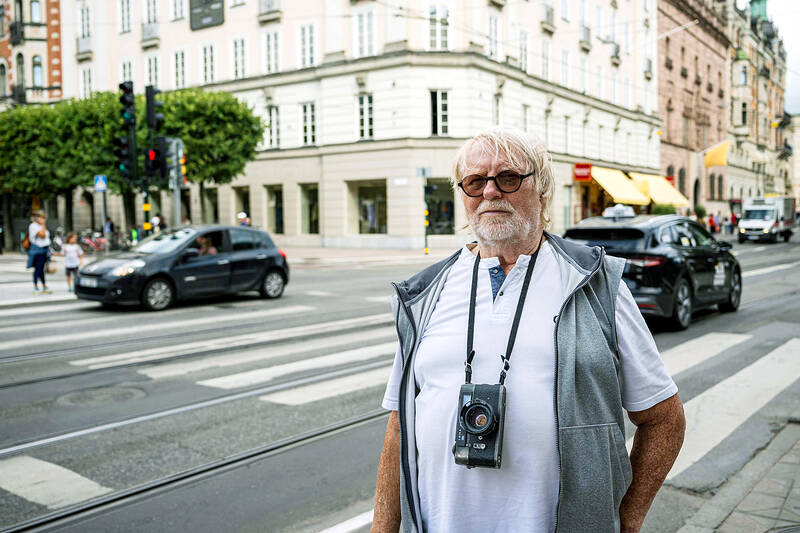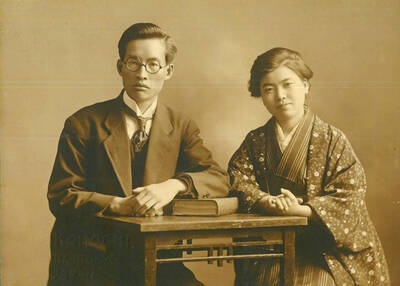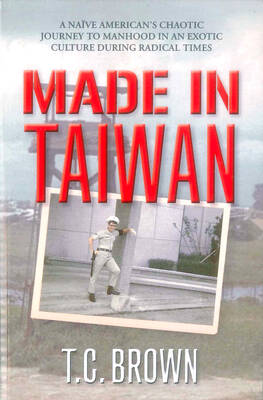“Get down to the floor! The party begins!” Shouting in English, Jan-Erik Olsson walked into a Stockholm bank on Aug. 23, 1973, high on drugs, agitated and waving a submachine gun.
So began a hostage drama that would go on to last six days, and birth the term “Stockholm Syndrome” — a concept now known around the world whereby captives develop an emotional bond with their captors.
Olsson, known by his nickname “Janne,” took four employees hostage — three women and one man.

Photo: AFP
Police and media quickly swarmed the square outside Kreditbanken, with snipers perched in surrounding buildings, their weapons pointed at the bank.
Olsson used two hostages as human shields and threatened to kill them.
“Afterwards, I’ve often thought of the absurd situation we found ourselves in,” recalled hostage Kristin Enmark, then 23, in her book I Became the Stockholm Syndrome.
“Terrified and stuck between two death threats, on one side the police and on the other the robber.”
‘FEARED FOR MY LIFE’
Olsson made several demands, asking for three million kronor (almost US$700,000 at the time), and that Clark Olofsson, one of the country’s most notorious bank robbers in prison at the time, be brought to the bank.
To calm things down, the Swedish government agreed. The entire country was mesmerized by the unfolding drama, one of the first major news events broadcast live on Swedish television.
“When Clark Olofsson arrived, he took control of the situation, he was the one who did the talking with the police,” recalled now 73-year-old Bertil Ericsson, a news photographer who covered the crisis.
“He had a lot of charisma. He was a good speaker.” Olsson calmed down as soon as Olofsson arrived. And Kristin Enmark quickly saw in Olofsson a savior.
“He promised that he would make sure nothing happened to me and I decided to believe him,” she wrote. “I was 23 years old and feared for my life.”
She spoke on the phone to authorities several times during the hostage drama, shocking the world when she came out in defense of her captors.
“I’m not the least bit afraid of Clark and the other guy, I’m afraid of the police. Do you understand? I trust them completely,” she told then prime minister Olof Palme in one phone call.
“Believe it or not but we’ve had a really nice time here,” she said, adding that they were “telling stories” and “playing checkers.”
“You know what I’m afraid of? That the police will do something to us, storm the bank or something.”
The crisis ended on the sixth day when police sprayed gas into the bank, forcing Olsson and Olofsson to surrender, and freeing the hostages.
‘NOT A PSYCHIATRIC DIAGNOSIS’
Psychiatrist Nils Bejerot was a member of the negotiating team. His job was to analyze the robbers’ and hostages’ behavior, and he ultimately coined the term “Stockholm Syndrome.”
At the time, the women were believed to be behaving as if under a spell, similar to being brainwashed.
Psychiatrists have since dismissed that notion.
Stockholm Syndrome is “not a psychiatric diagnosis,” says Christoffer Rahm, a psychiatrist at the Karolinska Institute and author of the scientific article “Stockholm Syndrome: Psychiatric Diagnosis or Urban Myth?”
Rather, the term is used to describe a “defence mechanism that helps the victim” cope with a traumatic situation, he said.
Cecilia Ase, gender studies professor at Stockholm University, said the statements by Enmark and the other women during the drama were interpreted by authorities “in a very sexualized dimension, as if they had fallen under the spell of a syndrome” and had lost all agency or ability to reason for themselves.
This perception was fueled by rumors of a relationship between Enmark and Olofsson.
While the two did go on to have a love affair years later, there is nothing to suggest the two had a relationship in the bank vault.
“There was no love or physical attraction from my side. He was my chance for survival and he protected me from Janne,” wrote Enmark, the inspiration for the character “Kicki” in the Netflix series Clark.
Ase argues that Stockholm Syndrome is a “constructed concept” used to explain how hostages behave when authorities and states fail to protect them.
The Stockholm hostages in fact “acted incredibly rationally,” she said.
“They called journalists, they fought (with police and politicians) to let the criminals take them out of the bank.”
“We represented a real threat to the hostages,” acknowledged police superintendent Eric Ronnegard in a book published years later. “With so many police officers surrounding the bank, there was a risk that one of the hostages could take a bullet.”
In a sign of their bitterness toward police, the hostages later refused to testify against their captors. Most people can identify with the concept on a psychological level, Rahm said, noting that emotional bonds with someone posing a threat are also common in abusive relationships.
Understanding a victim’s psychological reaction also helps relieve them of their guilt, he said.

Aug. 25 to Aug. 31 Although Mr. Lin (林) had been married to his Japanese wife for a decade, their union was never legally recognized — and even their daughter was officially deemed illegitimate. During the first half of Japanese rule in Taiwan, only marriages between Japanese men and Taiwanese women were valid, unless the Taiwanese husband formally joined a Japanese household. In 1920, Lin took his frustrations directly to the Ministry of Home Affairs: “Since Japan took possession of Taiwan, we have obeyed the government’s directives and committed ourselves to breaking old Qing-era customs. Yet ... our marriages remain unrecognized,

During the Metal Ages, prior to the arrival of the Dutch and Chinese, a great shift took place in indigenous material culture. Glass and agate beads, introduced after 400BC, completely replaced Taiwanese nephrite (jade) as the ornamental materials of choice, anthropologist Liu Jiun-Yu (劉俊昱) of the University of Washington wrote in a 2023 article. He added of the island’s modern indigenous peoples: “They are the descendants of prehistoric Formosans but have no nephrite-using cultures.” Moderns squint at that dynamic era of trade and cultural change through the mutually supporting lenses of later settler-colonialism and imperial power, which treated the indigenous as

An attempt to promote friendship between Japan and countries in Africa has transformed into a xenophobic row about migration after inaccurate media reports suggested the scheme would lead to a “flood of immigrants.” The controversy erupted after the Japan International Cooperation Agency, or JICA, said this month it had designated four Japanese cities as “Africa hometowns” for partner countries in Africa: Mozambique, Nigeria, Ghana and Tanzania. The program, announced at the end of an international conference on African development in Yokohama, will involve personnel exchanges and events to foster closer ties between the four regional Japanese cities — Imabari, Kisarazu, Sanjo and

By 1971, heroin and opium use among US troops fighting in Vietnam had reached epidemic proportions, with 42 percent of American servicemen saying they’d tried opioids at least once and around 20 percent claiming some level of addiction, according to the US Department of Defense. Though heroin use by US troops has been little discussed in the context of Taiwan, these and other drugs — produced in part by rogue Chinese Nationalist Party (KMT) armies then in Thailand and Myanmar — also spread to US military bases on the island, where soldiers were often stoned or high. American military policeman